The Glamorous Evolution of 80’s Dance Fashion for Men
Classic Influence: The Blend of Ballet and Street Style in Men’s 80’s Dancewear
The 1980’s marked a groundbreaking period in fashion, especially for men’s dancewear, where the seemingly opposing worlds of ballet and street style collided to create a distinctive, dynamic aesthetic. This blend wasn’t just about clothing—it was about movement, masculinity, and expression at a time when boundaries were being tested across fashion, music, and the arts.
Ballet’s Structural Elegance
Ballet has long been synonymous with grace, discipline, and body-conscious design. In the 80’s, this influence manifested in men’s dancewear through form-fitting silhouettes, stretchy fabrics like Lycra and spandex, and a focus on highlighting the dancer’s physique. Leotards, tights, and wrap sweaters—once confined to the studio—began making appearances in rehearsal spaces, stage performances, and even mainstream culture.
These ballet-inspired pieces brought with them a sleek, minimal aesthetic. Men wore off-the-shoulder tops, stirrup leggings, and legwarmers, items that emphasized the body’s lines and movements. This look wasn’t about softness—it conveyed strength, precision, and a new kind of sensuality that challenged traditional ideas of masculinity.
The Urban Edge of Street Style
At the same time, street style exploded, fueled by the rise of hip hop, breakdancing, and punk culture. Baggy sweatpants, oversized tees, bomber jackets, headbands, and sneakers became the staples of urban dance crews. This was a bold, rebellious aesthetic that celebrated individuality, improvisation, and defiance.
When streetwear collided with ballet’s clean lines, it resulted in a fascinating hybrid: dancers wore legwarmers with high-top sneakers, paired leotards with track jackets, and layered tank tops over mesh shirts. Accessories like fingerless gloves, gold chains, and visors added a gritty, rebellious flair to otherwise classically-inspired outfits.
Pop Culture Catalysts
Pop culture helped cement this fusion. Artists like Michael Jackson, Prince, and films like Fame and Flashdance – pushed this style into the spotlight. Jackson’s dancewear in particular—tight pants, loafers, cropped jackets—embodied the tension between elegance and street toughness. Dance troupes on shows like Solid Gold, brought spandex and sweats to millions of TV screens weekly.
Cultural Impact and Legacy
The blending of ballet and street style in men’s 80s dancewear reflected larger cultural shifts—an openness to androgyny, an embrace of physicality and fitness, and a desire to experiment. It democratized dancewear, allowing dancers to draw from both the discipline of ballet and the freedom of the streets.
Today, this legacy lives on in contemporary dancewear and fashion. Brands often reference this era in collections that combine performance-ready silhouettes with urban cool, while street dancers continue to wear ballet-inspired gear for both function and flair.
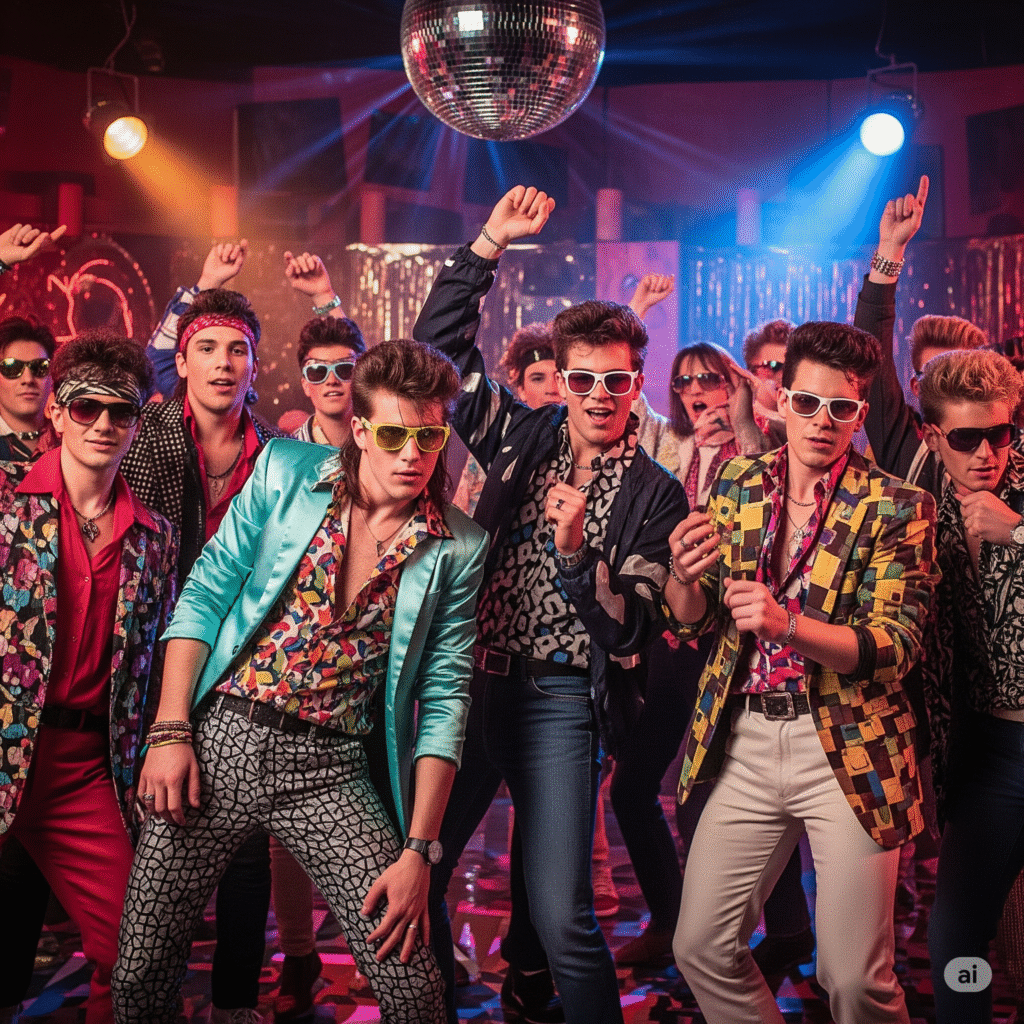
Statement Pieces: Notable Garments that Defined the 80’s Dance Scene
Below is a tailored version of “Statement Pieces – Notable Garments that Defined the 80’s Dance Scene – For Men”:
The 1980’s marked a golden era of dance culture—an explosion of creativity on the dancefloor fueled by breakdancing, hip-hop, funk, and MTV-driven pop. For male dancers, style was inseparable from movement. Their clothing needed to stretch, flow, and shock visually, turning every spin, freeze, and pop into a performance. These were the standout statement pieces that defined men’s dancewear in the 1980’s:
Parachute Pants
Nothing says 80’s dance like parachute pants. Designed for maximum mobility, these nylon pants with zippers and exaggerated silhouettes were perfect for breakdancers. Their swishing sound and metallic hues made every move audible and visible—transforming the body into a spectacle of movement. Here are a few examples of these types of pants including some way out styles – learn more here.
Tracksuits
The two-piece tracksuit—especially those from Adidas, Puma, and Kangol—was a cornerstone of street dance fashion. Often color-blocked or striped, tracksuits were both practical and iconic. Worn on the street, in rehearsal, or on stage, they symbolized unity, rhythm, and swagger. Though not many worn at dance clubs – it still symbolized freedom of movement. Some way out designs and colours to choose from through Amazon today – search them today.
Muscle Tees and Crop Tops
Exposing the midriff wasn’t just for women in the 80’s. Male dancers often wore cropped t-shirts or slashed tanks to show off their core strength and fluidity. Whether cut-off or mesh, these tops emphasized the torso and added a rebellious edge. Find your perfect muscle top or tee online through Amazon today.
High-Top Sneakers
Function met flair in the form of high-tops. Brands like Nike, Reebok, and Converse ruled the dance scene, offering ankle support and traction for fast footwork. Bright colorways and custom laces turned each pair into a statement. Many bright and bold styles to choose from right here – scroll through these.
Bandanas and Headbands
Worn across the forehead, tied around the neck, or wrapped on the wrist, bandanas and sweatbands were both practical and cool. They soaked up sweat mid-performance but also nodded to street culture and group identity—especially in breakdance crews. Bandanas of all styles can be located online through Amazon.
Leather Jackets and Bomber Coats
Outside the studio, leather and bomber jackets were popular among dance crews and pop dancers. With graffiti-style patches, pins, and bold linings, these jackets added attitude and a tough street aesthetic that contrasted with more functional rehearsal wear. Assorted jackets in leather, faux leather, fleece and bomber can be found today – learn more here.
Fingerless Gloves
Thanks to icons like Michael Jackson, fingerless gloves gained traction as a high-impact accessory. They added drama to hand movements and offered grip for dancers who performed acrobatics or used props. Scroll through the many styles available online at Amazon.
Statement Belts and Suspender Straps
Often worn loosely over the hips or diagonally across the chest – making a resurgence, these suspenders and belts were more about flair than function. They added movement, dimension, and a punk-meets-pop flavor to many male dance looks of the decade. A good selection of statement belts can be purchased here – buy yours today. Suspender straps of all kinds are also purchased through this site.
Layered Socks and Leg Warmers
Though more commonly seen in women’s fashion, many male jazz and contemporary dancers embraced ankle layering. Bright socks over tights or under cropped pants created a bold silhouette and made leg movements pop under stage lights. Not overly popular for men, but you might find some here amongst this selection.
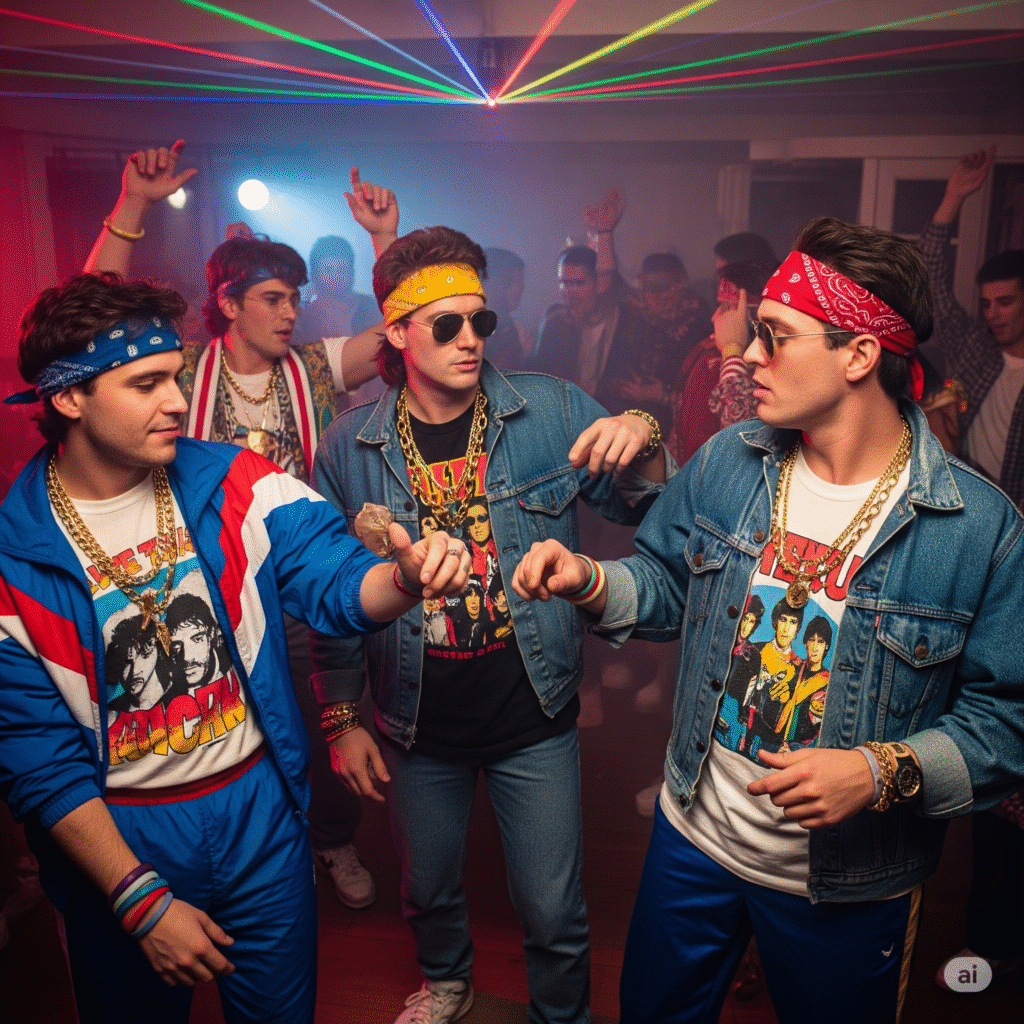
Why It Still Resonates
These garments weren’t just trend-driven—they were part of a larger cultural conversation. They reflected the merging of athleticism and artistry, masculinity and flair, discipline and rebellion. Male dancers in the 80s wore their identities boldly, and their wardrobe became an extension of their presence—on the floor, in the streets, and on screen.
The points below includes a concise headline, bold visuals in the collage below, and impactful copy – designed to grab attention and engage quickly:
🎯 Carousel Style: “Statement Pieces: 80’s Dance Fashion for Men”
Title Cover
🕺 Statement Pieces
The Bold Garments That Defined Men’s 80’s Dancewear
Vibrant. Athletic. Iconic.
Visual: High-energy collage: breakdancers, neon lights, MTV logo, and classic 80s fonts.
Parachute Pants
💨 The Movement Makers
Baggy, shiny, and born for breakdance battles.
Metallic fabrics and dramatic volume made every move pop.
Visual: Close-up of pants mid-spin, metallic nylon rippling.
Tracksuits
🎧 Street Meets Studio
Color-blocked, coordinated, and crew-ready.
Adidas, Puma, Kangol—uniforms of rhythm.
Visual: Dancers in matching tracksuits, graffiti wall background.
Crop Tops & Muscle Tees
🔥 Cut for Performance
Slashed, cropped, and rebellious.
Showing strength, sweat, and style.
Visual: Male dancer mid-leap in a cropped tee, neon lights behind.
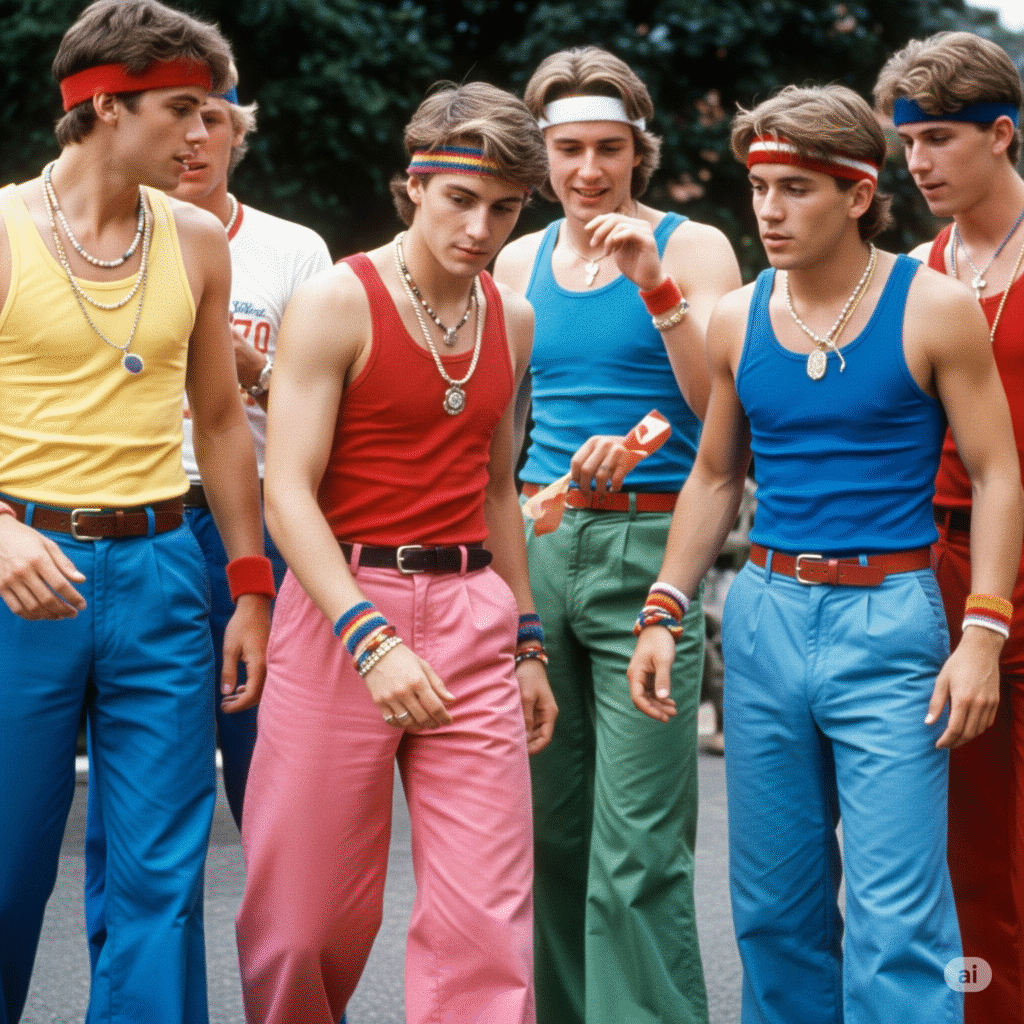
High-Tops
👟 Style with Sole
Nike, Reebok, Converse classics.
Ankle support for every pop and lock.
Visual: High-top close-up on a breakdancer’s foot mid-spin.
Bandanas & Headbands
🧢 Crew Identity
Worn loud and proud—on heads, wrists, and necks.
Practical meets streetwise style.
Visual: Portrait-style image of a dancer with bandana and sweatbands.
Leather & Bomber Jackets
🖤 Tough on the Outside
Graffiti patches. Bold linings.
For street swagger between rehearsals.
Visual: Male dancer with open bomber jacket, striking pose.
Fingerless Gloves
🧤 MJ-Inspired Drama
A hand accent that amplified every gesture.
Dance-ready with a hint of glam.
Visual: Close-up of gloves mid-performance, spotlighted.
Statement Straps
🪢 Belts & Suspenders
Slung low, worn high—pure flair.
An edge of punk and pop in every bounce.
Visual: Dancer in motion, straps flying.
Why It Still Resonates
🌟 Legacy in Motion
These weren’t just clothes—they were culture.
The energy, identity, and edge of 80s dancewear lives on.
Visual: Split screen: vintage 80s vs. modern fashion revival
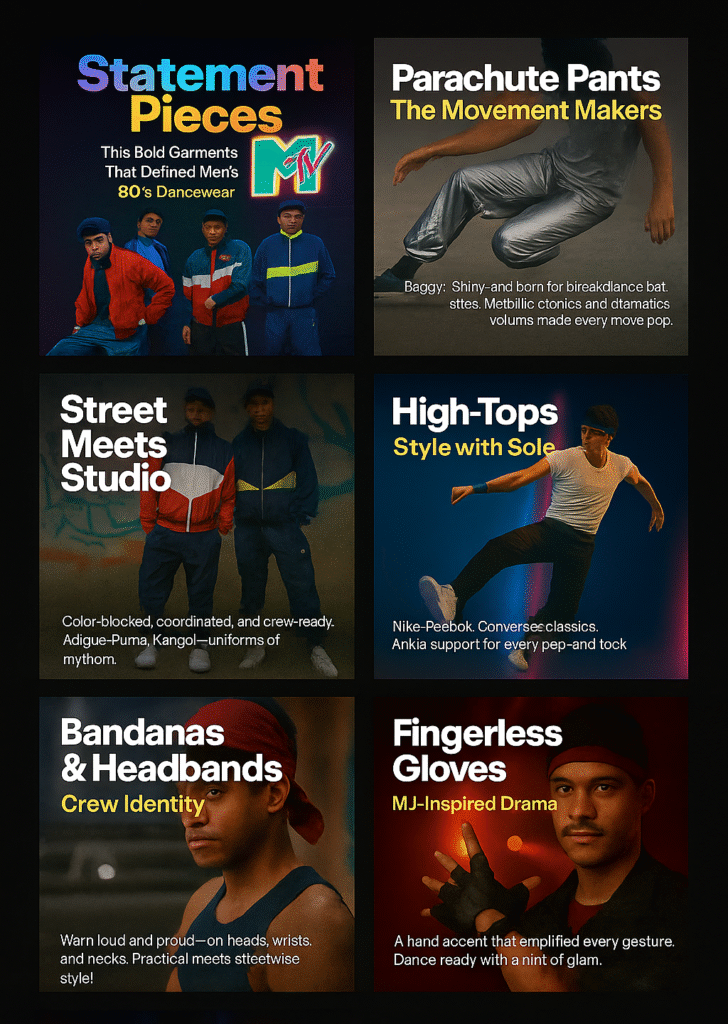
Accessorizing with Flair: The Power of Accessories in Creating Iconic Looks
🎯 Visual Carousel Concept
Subtitle: The Power of Accessories in Creating Iconic ‘80s Dance Looks for Men
Title Cover
🕶️ Accessorizing with Flair
How ’80s dancers used bold accessories to become icons
Visual: A montage of dancers wearing sunglasses, chains, gloves, and bandanas with neon accents and VHS glitch effects.
Bandanas & Headbands
💥 Crew Identity in Color
Tied on foreheads, necks, or wrists—these weren’t just functional.
They were badges of honor in battle.
Visual: Breakdancer tying a red bandana, backdrop of a graffiti wall.
Fingerless Gloves
🖐️ Drama in Every Gesture
Leather or mesh, these gloves amplified every hand movement.
Think MJ meets underground grit.
Visual: Gloved hands mid-pose under spotlight.
Chains & Necklaces
⛓️ Golden Swagger
Heavy gold, layered dog tags—bling that meant business.
Street style turned stage-ready.
Visual: Close-up on a dancer’s neck/chest layered in chains. Accessorize with chains or necklaces to stand out amongst others with these today.
Sunglasses
🕶️ Mystique & Motion
Mirrored lenses. Oversized frames.
Confidence with every pop and lock.
Visual: Dancer mid-move, shades glinting under club lights. 80’s style shades are found here – learn more today.
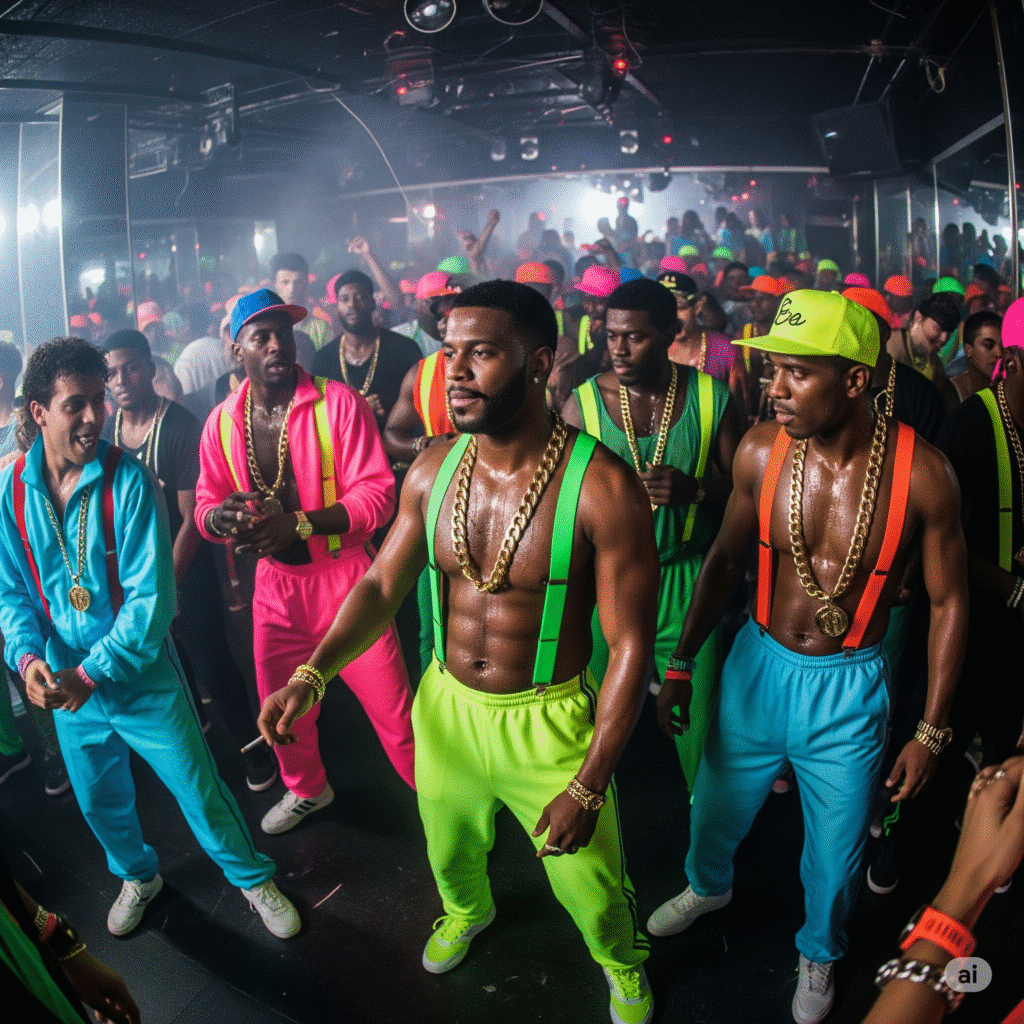
As an affiliate - I may receive a small commission when you click on a link and purchase through this site.
Suspenders & Belts
📎 Punk & Purpose
Worn low or clipped loose, these pieces added kinetic style.
More flair than function.
Visual: Snapshot of dancer in a cropped tee with dangling suspenders.
Wristbands & Arm Cuffs
💪 Athletic Edge
Neon terry cloth or futuristic metallics—these framed the movement.
An 80s essential.
Visual: Arm close-up mid-wave, colorful wristband glowing. Wrist bands of all kinds including edgy styles can be purchased here online.
Hats & Caps
🎩 The Finishing Frame
From Kangol to snapbacks—hats crowned every look.
Each silhouette said something.
Visual: Profile shot of dancer adjusting his cap, backlit for drama. Fashionable caps and hats from the era – choose yours today.
Closing Slide – The Legacy
🌟 Accessories with Attitude
More than fashion—these were statements.
The power of detail, the soul of the scene.
Visual: Collage of all accessory types, with bold typography:
“Style that moved with you.”
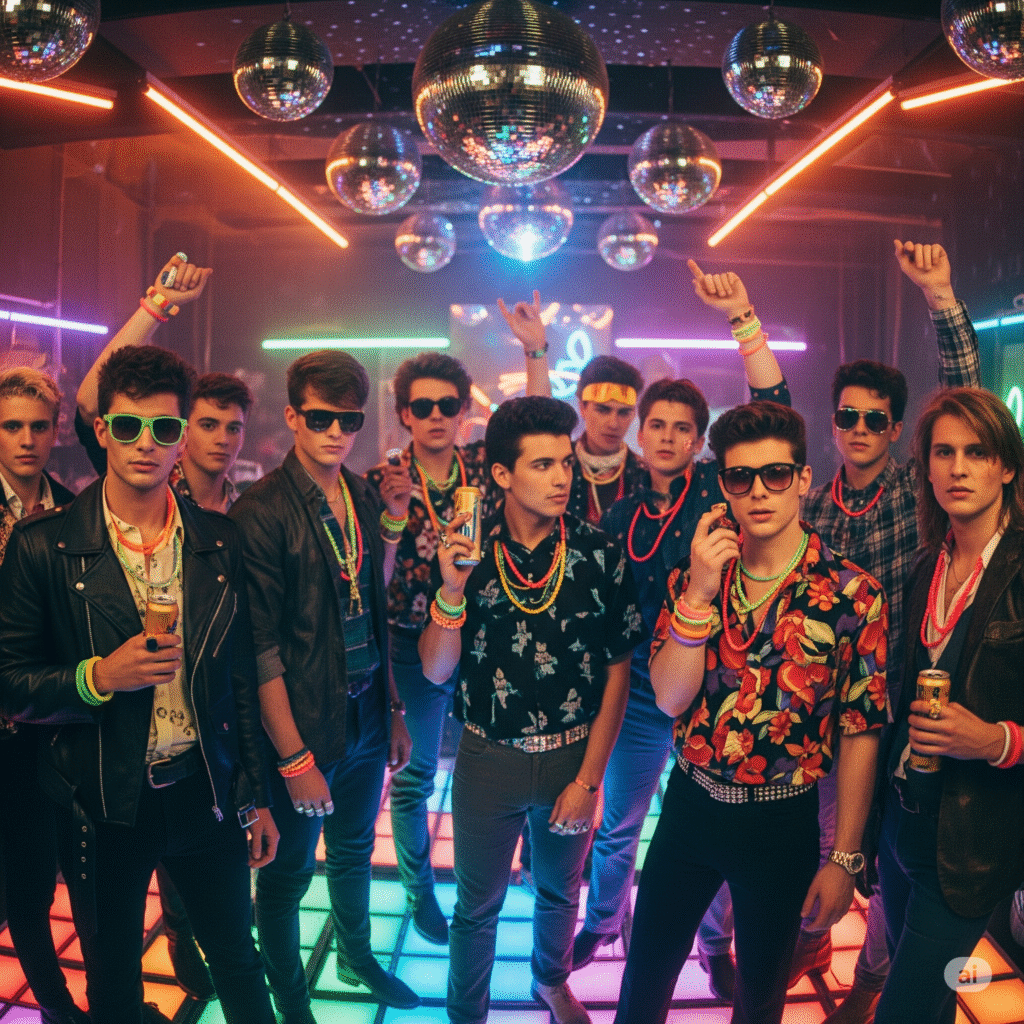
Icons of the Era: Key Male Dancers and Influences Shaping Dance Fashion
In the electric atmosphere of the 1980’s, a wave of male dancers didn’t just move to the beat—they set it. Their influence extended beyond choreography, shaping the very fabric of fashion for a generation. These men became living style icons, blending athleticism, rebellion, and glamour to forge a new visual language in dance.
Michael Jackson – The Master of Movement and Style
From the glittering glove to the military-style jackets, Michael Jackson defined 80’s dance fashion. His lean silhouette, loafers with white socks, and sharply tailored ensembles became instantly iconic. Each outfit was choreographed as meticulously as his routines—turning fashion into part of the performance.
Shabba Doo (Adolfo Quiñones) – The Streetwear Innovator
As a member of The Original Lockers and star of Breakin’, Shabba Doo brought locking and popping to the mainstream—and with it, street-infused style. Known for his flamboyant vests, wide-brim hats, and slouchy pants, he elevated urban dance fashion with flair and finesse.
Turbo (Michael “Boogaloo Shrimp” Chambers) – The Futurist
Boogaloo Shrimp’s signature robot and electric boogaloo style came with equally distinctive fashion: metallic fabrics, cropped sweats, and track jackets. His look channeled sci-fi and tech aesthetics, mirroring the mechanical movements he mastered.
Jean-Claude Van Damme – The Martial Artist Dancer
Though known for action films, Van Damme’s flexibility, splits, and high kicks contributed to a martial-arts-meets-dance hybrid. His tight tank tops, karate pants, and headbands influenced both workout and streetwear styling in dance circles.
Bobby Brown – New Jack Swing Swagger
Bridging R&B and hip-hop, Bobby Brown helped usher in the “New Jack Swing” era. His fashion sense was bold: oversized jackets, gold chains, leather pants, and clean-cut high-top fades. His style was both accessible and aspirational for male dancers everywhere.
Prince – The Rule-Breaking Dandy
Though not strictly a dancer, Prince’s androgynous style and sensual stage presence made a deep impact. From lace gloves and heeled boots to fitted suits and ruffled shirts, he expanded the boundaries of masculinity in dance fashion.
The Rock Steady Crew – Hip-Hop’s Vanguard
This pioneering breakdance crew set the tone for early hip-hop style. With Kangol hats, Puma tracksuits, and graffiti-inspired accessories, they defined a raw, authentic, and deeply influential look that bridged street culture and stage performance.
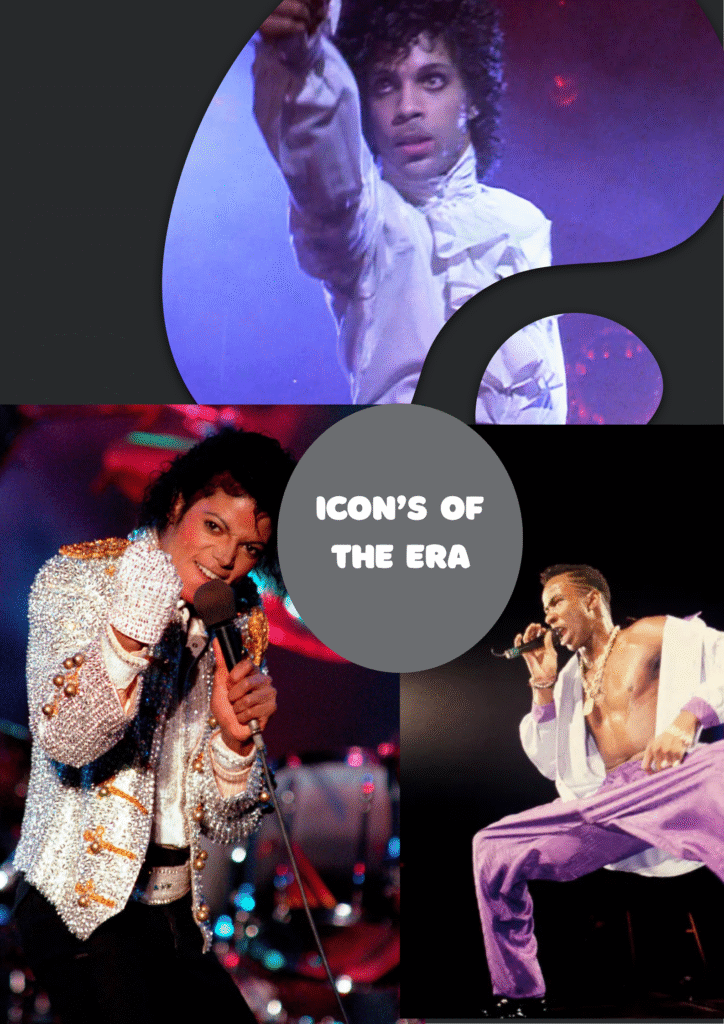
Legacy in Motion
These icons didn’t just dance—they dressed the part. Whether through glittering glam, urban streetwear, or athletic tailoring, their influence helped shape a generation’s perception of what it meant to move with style. Their fashion was not separate from their artistry—it was integral to it.
Retro Revolution: How the 80s Dancewear Thrives at Today’s Retro Events
The 1980’s dancewear revolution was never just a trend—it was a full-throttle expression of movement, identity, and flair. Decades later, those same bold looks are making a powerful comeback at retro-themed parties, dance battles, festivals, and fashion-forward gatherings. But this isn’t just about nostalgia—it’s a revival, with 80s dancewear thriving in today’s style scene in new and creative ways.
Neon Never Dies
From highlighter pink leotards to electric blue windbreakers, neon was the lifeblood of 80’s fashion—and it’s still lighting up retro events. Today’s partygoers pair vibrant crop tops, leggings, and shell suits with LED accessories, bringing vintage color schemes to life under modern club lights.
Tracksuits & Street Cred
Retro dance competitions and throwback nights are prime territory for iconic 80s tracksuits. Whether it’s Adidas stripes or Fila flair, the matching set has returned as a fashion staple. Modern revivals blend authenticity with irony, mixing original vintage finds with reissued designs.
Dance Battles Go Old School
Events like breakdance throwdowns, roller discos, and funk revival nights are more than just entertainment—they’re visual time capsules. Parachute pants, sleeveless hoodies, and fingerless gloves help today’s dancers channel the energy of Rock Steady Crew or Turbo from Breakin’ while showcasing their own twist on retro flair.
Accessories Make the Look
No 80’s outfit is complete without accessories: oversized sunglasses, sweatbands, gold chains, and snapback caps are back in force at retro festivals. Attendees are embracing the over-the-top ethos, proving that when it comes to 80’s fashion – where more is more.
Modern Spins on Classic Footwear
Footwear favorites like Reebok Freestyles, Nike Airs, and Converse high-tops are still seen stomping on today’s dance floors. Now often customized or color-clashed, they pay homage to the era’s style while stepping confidently into the present.
Gender Fluidity & Expression
One of the most exciting aspects of today’s retro revival is the embrace of 80’s fashion’s flamboyant freedom. Men now sport crop tops, shimmering fabrics, and layered accessories in the same fearless spirit as Prince or Bobbie, blurring lines and celebrating expression.
The 80s: More Than a Costume
At retro events, 80’s dancewear isn’t just a dress code—it’s a culture. It allows people to inhabit the bold, expressive, and unapologetic spirit of a decade that championed individuality through movement and fashion. Whether you’re locking in neon tights or spinning in a metallic jacket, the vibe is the same: dance like everyone’s watching—and dress like they won’t forget it.
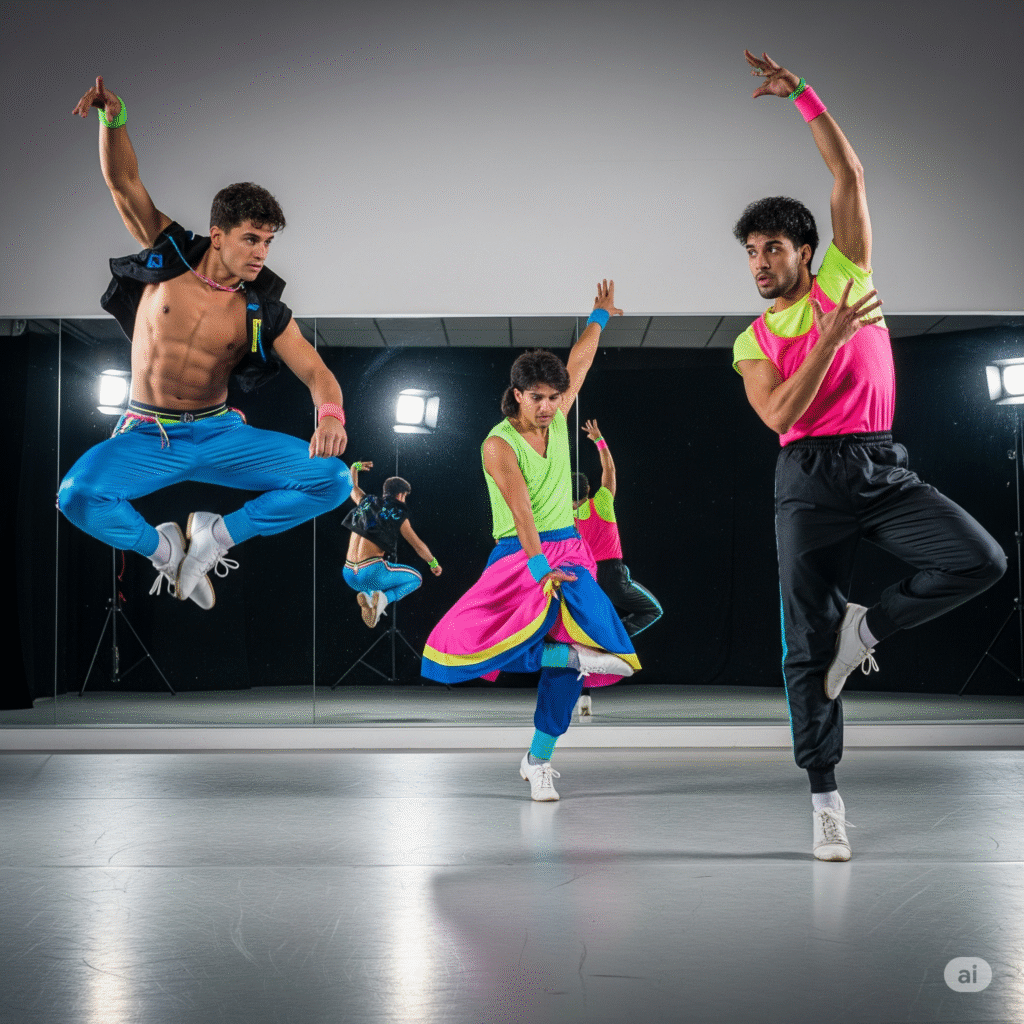
Sustainability and Ethical Fashion: Reimagining 80s Styles for Modern Consciousness
The 1980’s was a decade of extravagance—bold prints, synthetic fabrics, and fast-fashion appeal. But as the fashion world shifts toward sustainability and ethical production, 80’s dancewear is experiencing a thoughtful revival. Today’s designers, dancers, and vintage lovers are finding ways to embrace the flair of the decade while aligning with modern values of environmental responsibility and social awareness.
Vintage is the New Black
One of the most sustainable fashion choices? Wearing what already exists. Thrifting original 80’s garments—think parachute pants, oversized blazers, and graphic muscle tees—keeps clothing in circulation and out of landfills. Vintage boutiques and resale platforms now celebrate 80’s fashion as both a nostalgic and eco-conscious choice.
Upcycling the Iconic
Creative individuals are transforming retro finds into modern masterpieces. Old windbreakers become patchwork bombers, worn-out leggings turn into dance shorts, and vintage tees are cropped, dyed, and restyled. This approach not only reduces waste but also captures the do-it-yourself spirit that defined 80’s street fashion.
Ethical Materials, Classic Shapes
Designers inspired by 80’s silhouettes are now crafting new collections using organic cotton, recycled polyester, and plant-based dyes. Think power-shoulder jackets made from deadstock fabric or neon-toned dancewear produced in fair-trade factories. It’s the best of both worlds: style with a conscience.
Slow Fashion Meets Fast Moves
Unlike fast fashion, slow fashion prioritizes quality and longevity—just like the durable gear dancers used in the 80’s. Today’s reimagined 80’s-inspired pieces are built to last, whether you’re hitting the floor or the street. Functionality and flair are no longer at odds.
Inclusive and Ethical Representation
The 80’s dance scene was a celebration of individuality across race, gender, and identity—values that resonate in today’s movement toward ethical representation. Brands revisiting 80’s aesthetics are amplifying diverse voices, challenging stereotypes, and promoting body-positive, gender-fluid fashion inspired by legends like Prince and the underground ballroom culture.
Community-Driven Style
Fashion collectives, dance crews, and upcycling communities are using social media and pop-ups to share, swap, and celebrate sustainable 80’s fashion. It’s not just about looking the part—it’s about belonging to a movement that values creativity, connection, and conscious consumption.
Looking Back to Move Forward
Reimagining 80’s style through a sustainable lens isn’t about dialing down the drama—it’s about channeling it with purpose. By merging retro aesthetics with modern ethics, today’s fashion revival honors the past while investing in a better future. Dancewear, like the culture it represents, can still move with boldness—only now, it moves mindfully.
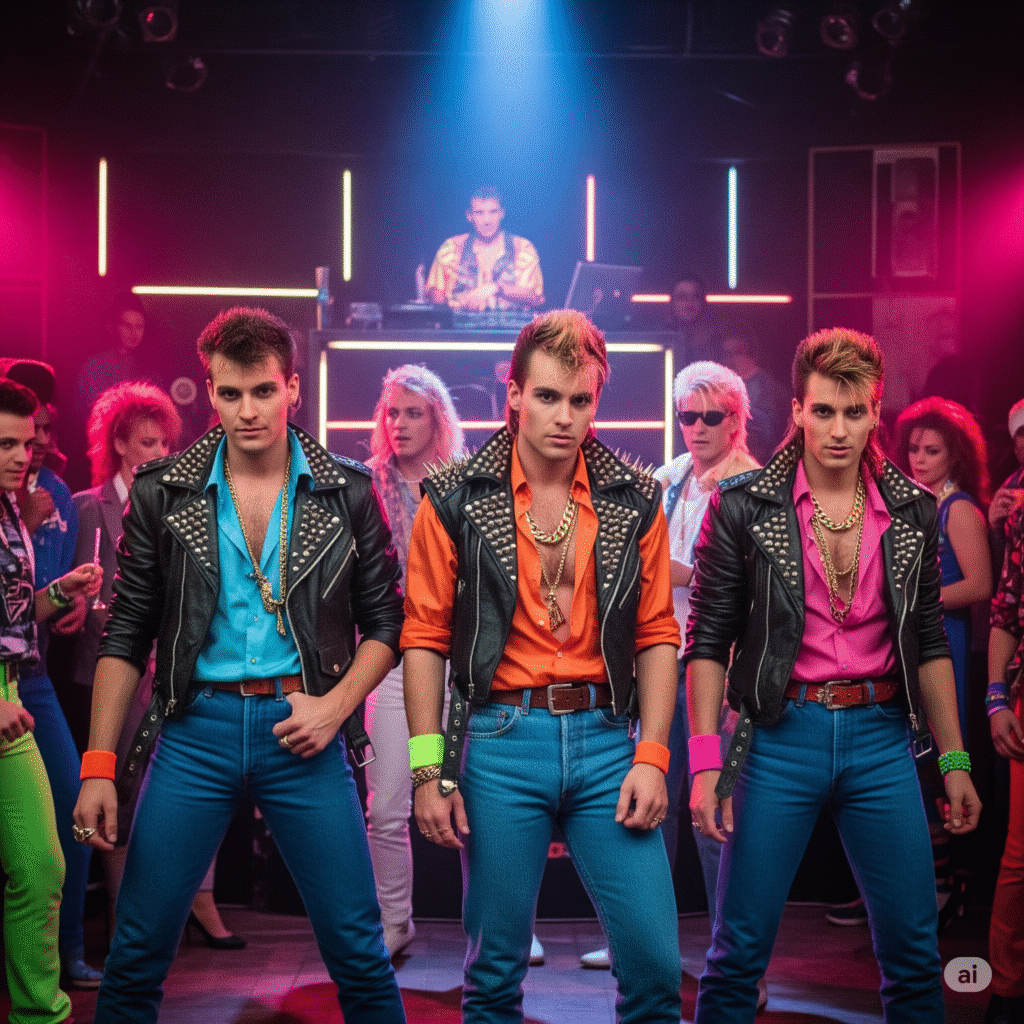
I hope you gained some inspiration from this post on the fashionable Danseur – an insight into what was worn during the 80’s at dance venues.
Leave a message below or follow us on our socials here:
https://www.facebook.com/vintageclothesandaccessoriesaustralia
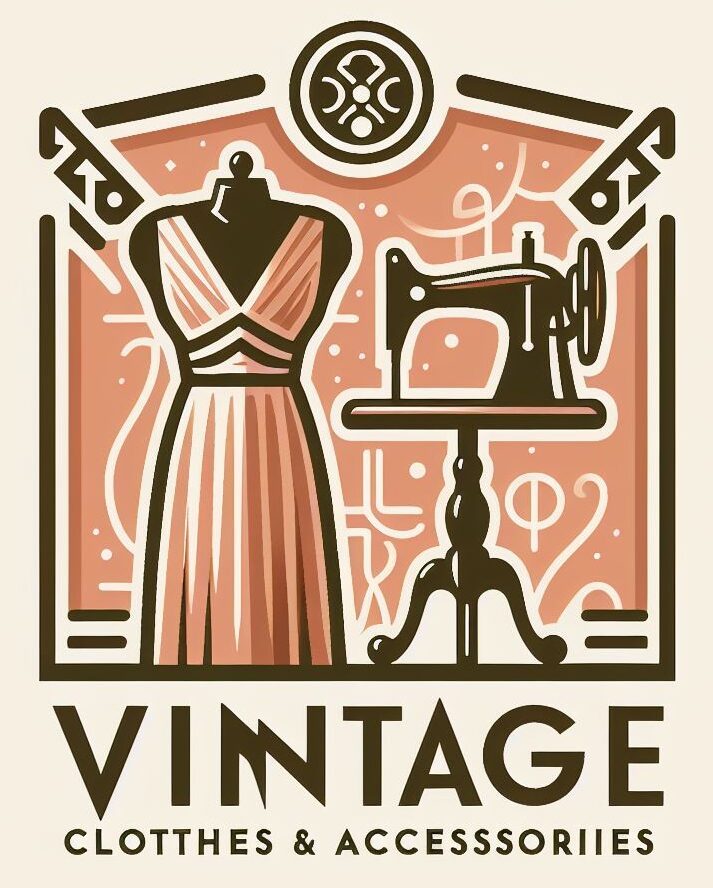
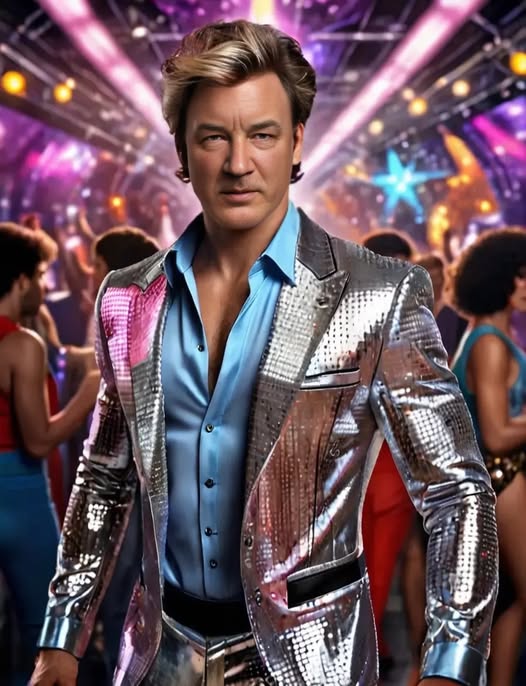
This was such a vibrant and nostalgic deep dive into men’s 80s dancewear! I loved how you captured the contrast and fusion between ballet’s structured elegance and street style’s raw energy. It really showed how fashion can mirror cultural shifts. The details on statement pieces like parachute pants and muscle tees brought the era alive. Do you think we’re due for a modern revival of this bold, expressive style in today’s dance or street fashion scenes?
Hi Kavitha, thanks for your comments. I’m not a big fan of the street apparel as it generally refers to a more youthful look with a grunge twist. However I honestly think designers are running out of ideas – fashion has come full circle in many ways and they do incorporate a lot of expressive styles – at least on the runways. It remains to be seen which way fashion heads now with our ever changing world.